5 Facts About Black Women in the Labor Force
By: Mathilde Roux | April 3, 2023
Black women are an integral part of the American labor force but have long faced a pay gap due to longstanding inequities in education and the labor market. In addition, they have been disproportionately impacted by the pandemic. Black women workers are overrepresented in low-paying service sector jobs, which were among the hardest hit, in terms of job losses.
Aug. 3, 2023, marks Black Women’s Equal Pay Day, a symbolic representation of the number of additional days Black women working full-time, year-round, must work, on average, to earn what white, non-Hispanic men earned the year before.
Here are five facts about Black women in the labor force:
1. Black women earn 63 cents for every dollar earned by white, non-Hispanic men
Black women’s earnings are 63.0% of white, non-Hispanic men’s earnings – the third-widest gap after Native women (60%) and Hispanic women (55.4%). In comparison, white, non-Hispanic women earn 78.7% of white, non-Hispanic men’s earnings, and Asian women earn 87.1%.
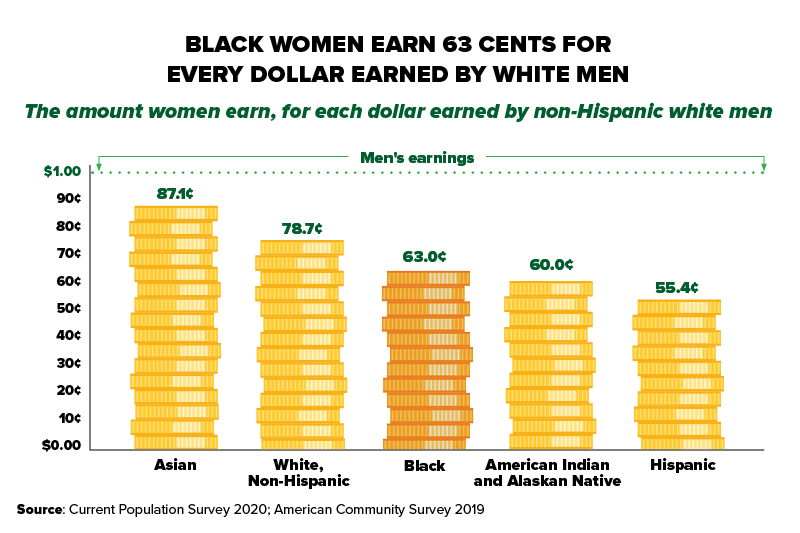
2. This wage gap is not just driven by educational differences
Even controlling for education, Black women still earn less than their white male counterparts. Among those with a bachelor’s degree, Black women only earn 65% of what comparable white men do, for instance. And among people with advanced degrees, Black women earn 70% of what white men do. In fact, Black women with advanced degrees have median weekly earnings less than white men with only a bachelor’s degree.
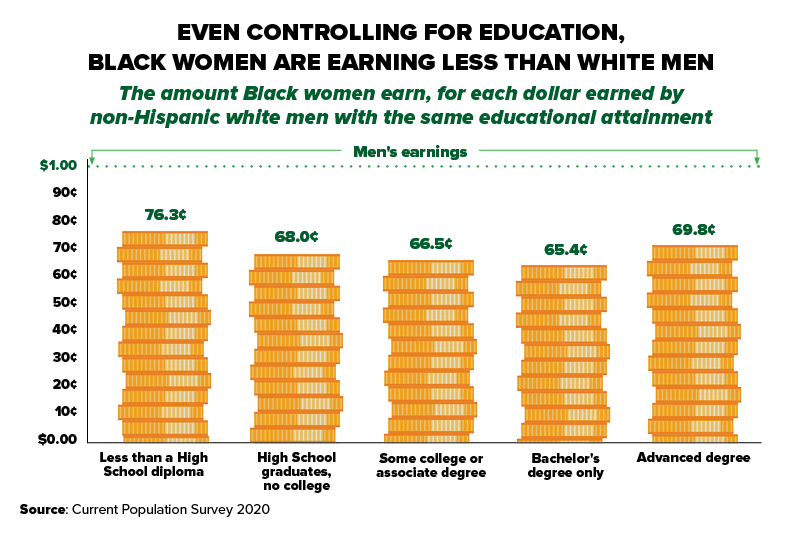
3. Black women have the highest labor force participation rate of all women
Typically, Black women have higher labor force participation rates than other women, meaning a higher share of Black women are either employed or unemployed and looking for work. For instance, in 2019, Black women's labor force participation rate was 60.5% compared with 56.8% for white women. Even in 2020, in the midst of the pandemic, their labor force participation rate was 58.8%, compared to 56.2% for women overall.
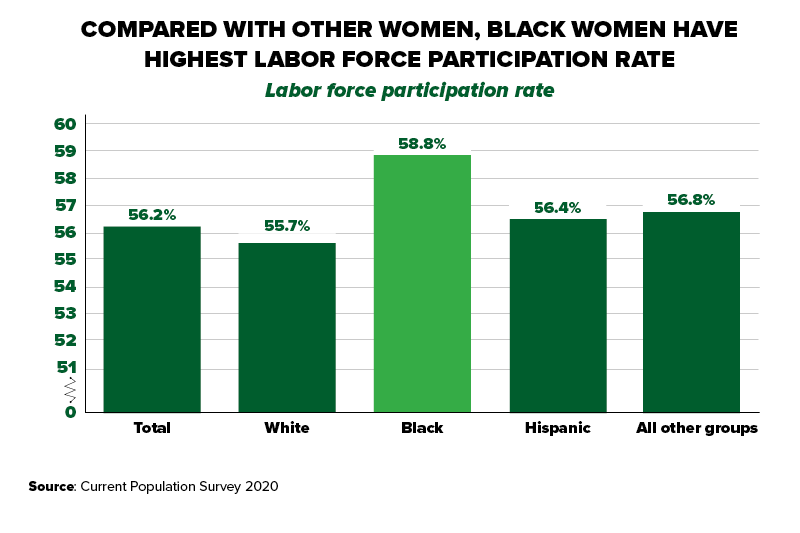
4. Black women have also experienced high unemployment, especially in the wake of the pandemic
In 2020, Black women’s unemployment rate was 10.9%, compared to 7.6% for white women and 8.3% for all women. This is no doubt reflective of the steep job losses and slow job recovery experienced by this group since early 2020, though even prior to the pandemic, their unemployment was relatively high (5.6%) compared with white (3.2%), Asian (2.7%) and Hispanic (4.7%) women.
5. Black moms, too, have relatively high labor force participation rates
Black mothers – two-thirds of whom are equal, primary or sole earners in their households – have higher labor force participation rates than other moms. This has historically been the case, and 2020 was no exception: 76.0% were in the labor force, compared with 71.3% of white moms, 62.8% of Hispanic moms and 64.3% of Asian moms.
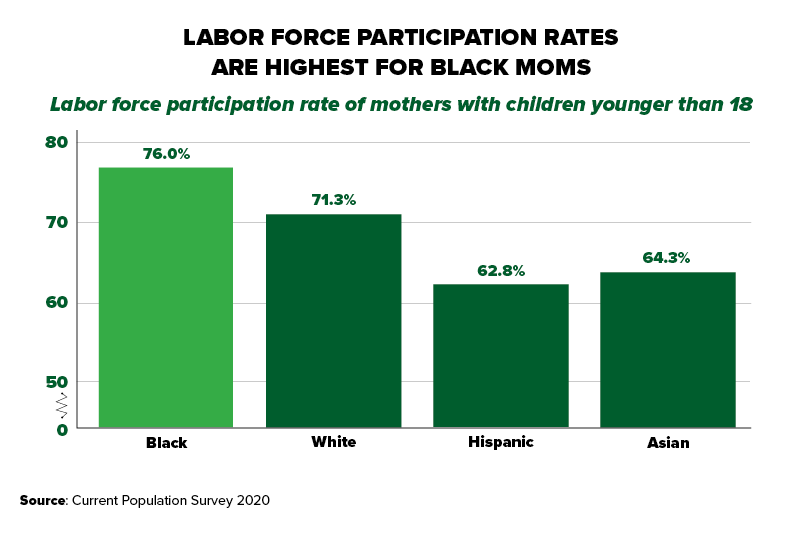
Mathilde Roux is a Presidential Management Fellow in the department's Women's Bureau. Follow the bureau on Twitter @WB_DOL.
More Than Statistics: How COVID-19 is Impacting Working Women
By Eleanor Delamater, Gretchen Livingston | July 21, 2023
|
Over the past several months, the Women’s Bureau has been asking women to tell us about their personal experiences during the pandemic, and what support they need going forward. We’ve heard from women all over the country who work in all different occupations and industries. Many have shared similar observations about what would help them in the workforce: paid leave, access to child care, flexible work arrangements and supports for transitioning back to the workforce. Here are just a few of their stories. For Jesse and LaTanya, having a national, comprehensive paid medical and family leave policy would have helped them maintain financial stability throughout the pandemic and beyond. Jesse, a single mom, lost her job and ultimately her home when she contracted COVID. Meanwhile, LaTanya had to choose between her financial security and the health of her baby with respiratory issues. |
||
|
When the pandemic hit I was a self-sustaining single mom of my 15-year-old daughter working at [a big box store] as head cashier. I got really sick with Covid and I was terminated during my paid leave for it. For 2 months I fought for my position to be reinstated and it finally was. But we lost our home and I got much sicker during those 2 months. We are living with my 87-year-old grandmother and I'm advocating for there to be a stricter leave law in place for anyone who catches Covid especially while working as an essential employee! – Jesse, Tennessee |
 |
|
|
So when Covid hit I was working in the medical field and had a very young baby, who experiences breathing difficulties. So having that in the back of my mind I felt the right thing to do in the situation was to protect her the best way I knew how, which was to leave [my] job and just stay with her full-time. At one point I was facing eviction and even about to have my car repossessed. But, my daughter's health and safety was/is way more important to me than any material things. Covid has not been all bad for me though. I was able to watch my daughter take her first steps. I'm so glad I got to see that! – LaTanya, Missouri |
|
|
|
Blair has struggled with new motherhood during COVID, especially given the lack of child care options. Work flexibility has helped her manage, but she’s not sure how much longer that will be an option for her. |
|
|
|
Being a first-time mom during a global pandemic has been an experience, that's for sure! I was pregnant, gave birth, had 3 months of maternity leave, and returned to work all during the COVID-19 pandemic. My original plan of daycare had to change. I've had to ask for an exception to continue to work from home ... Trying to manage breastfeeding, working 40 hours a week, and managing the care for a baby has been one of the biggest challenges of my life. – Blair, Illinois |
 |
|
|
Like many, Mary lost her small business. She wants to get back to work, but needs support finding employment, and job flexibility so she can fulfill her caregiving responsibilities, too. |
|
|
|
I was a business owner in Las Vegas and due to pandemic lost my business. I would still like to work but have been out of the job market for some time. I have been receiving [Pandemic Unemployment Assistance] but I am now being asked to apply for jobs. I received no help with small business loans or any help from state, federal or local entities. I cannot go back into the work place because of my husband’s disability and the lack of job skills. What kind of help is available to me? – Mary, Nevada
|
|
|
|
Then there are women like Shara, who remind us just how resilient we can be, and that we have to not only recover, but build a new, better economy that works for everyone. |
|
|
|
Covid came blasting into our lives taking away but it also enriched us to find more innovative ways to reach out – more phone calls and video chats – realizing we had to realign our priorities to embrace those that we love... I rise to see if I can make a difference and I will continue to contribute – I am proud to be a [woman] and all that we stand for. – Shara, Colorado |
 |
|
This pandemic has disproportionately impacted women. The adult women’s employment rate (54.3%) is at its lowest pre-pandemic level since September 1988 (54.1%). In June, there were 7.2% fewer adult Black women, 5.9% fewer adult Hispanic women, and 4.8% fewer adult white women employed compared with February 2020.
Mothers of young children had the steepest reductions in employment during 2020. Among mothers with children under the age of 13, 1.2 million fewer mothers were working, representing loss of about 7% of employed mothers ages 25-54.
But working women are more than just statistics. They are human beings with names, unique stories and individual challenges that require solutions. To meet the demands of a recovering economy, without giving short shrift to family and individual care needs, these women, and so many more who toil in anonymity, need a comprehensive national paid leave program, access to affordable child care, and workplaces willing to accommodate the needs of working families. This moment is ripe with opportunity to re-envision the full spectrum of work-family policies necessary to create a workforce that is better and stronger than it was pre-pandemic.
Eleanor Delamater is a presidential management fellow and Gretchen Livingston is a survey statistician for the U.S. Department of Labor’s Women’s Bureau. Follow the bureau on Twitter: @WB_DOL.
We want to continue to hear about your unique challenges and what solutions you need in order to best advocate for all working women. Please share your story with us: https://www.dol.gov/agencies/wb/wb100/story
Even Prior to Pandemic, Working Women Couldn’t Take Time Off When They Needed
by Gretchen Livingston | June 17, 2023
The COVID pandemic has thrown into sharp relief the struggles of working women in the U.S., amplifying the challenges they face as they try to succeed in the labor market while juggling family and personal responsibilities.
Even before COVID, though, many were in the position of needing time off but not being able to take it. Indeed, among all working women in the U.S., 1 in 10 had that exact experience in the prior month, according to the 2017-2018 American Time Use Survey Leave Module, a nationally-representative survey by the Bureau of Labor Statistics sponsored by the Women’s Bureau.
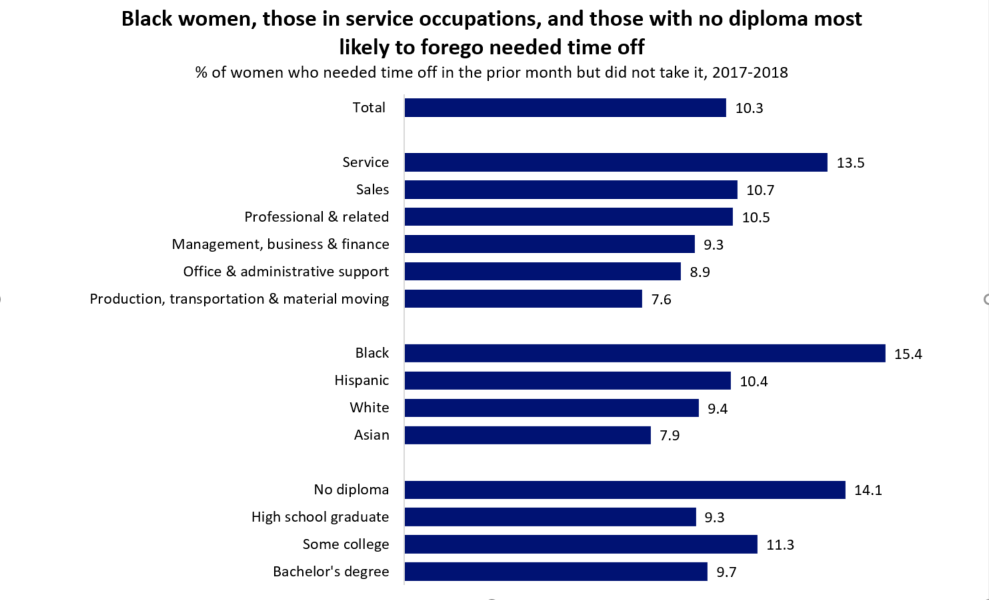
Notes: Based on the main job of employed civilian, non-institutionalized women ages 16 and older. Results not shown for women in Natural resources, construction & maintenance due to insufficient sample size. Hispanics may be of any race. Data: Bureau of Labor Statistics, American Time Use Survey Leave Module 2017-2018. Graphic: U.S. Department of Labor Women's Bureau. (plain text chart below)
Women working in service occupations – who were also the least likely to have access to paid leave – were among the most likely to report having needed but not taken leave (13.5%). The shares foregoing leave were also high among African American women (15.4%) and those lacking a high school diploma (14.1%).
On the flip side, women working in production, transportation and material moving, and Asian women were among the least likely to report having needed but not taken leave (7.6% and 7.9% did so, respectively).
Notes: Based on the main job of employed civilian, non-institutionalized women ages 16 and older. Respondents could provide more than one reason. Data: Bureau of Labor Statistics, American Time Use Survey Leave Module 2017-2018. Graphic: U.S. Department of Labor Women's Bureau. (plain text chart below)
By far the largest share of all women who needed but didn’t take leave (42%) reported needing to take off for their own illness or medical care. Sizeable shares also reported needing time off for errands or personal needs (26%), or to care for a family member who was ill or had medical needs (20%). Some 8% needed but did not take time off for child care (respondents could report more than one reason for needing time off).
Why in these cases did women not take leave? For many, taking off was simply not an option: 12% said that they could not afford to lose the income, 11% were denied leave, and 10% feared reprisals for taking time off, for instance.
Notes: Based on the main job of employed civilian, non-institutionalized women ages 16 and older. Respondents could provide more than one reason. Data: Bureau of Labor Statistics, American Time Use Survey Leave Module 2017-2018. Graphic: U.S. Department of Labor Women's Bureau.(plain text chart below)
Women were equally likely to report foregoing needed time off, whether they had access to paid leave or not. However, the experiences of these two groups of women did differ in other ways. Those who didn’t have paid leave were more likely to say they needed the time off to care for their own illness or medical needs (50% vs. 35%), and were almost five times more likely to say that they didn’t take off because they could not afford to do so (24% vs. 5%).
In contrast, women with paid leave were slightly more likely to say that they needed the leave for errands or other personal reasons (29% vs. 22%) and were more likely to forego the leave because they had too much work (29% vs. 12%).
Notes: Based on the main job of employed civilian, non-institutionalized women ages 16 and older. Data: Bureau of Labor Statistics, American Time Use Survey Leave Module 2017-2018. Graphic: U.S. Department of Labor Women's Bureau. (plain text chart below)
The snapshot of data here reveals that pre-pandemic, 1 in 10 women reported unmet need for leave in the month prior, and these needs seemed particularly acute for those lacking paid leave. The struggles brought on by COVID since that time have been so wide ranging, so overwhelming and so salient, that the national conversation about paid leave, personal care and care work responsibilities has been elevated in a new way.
A number of states and cities in the U.S. have already adopted some form of paid leave legislation, as have all other OECD nations. It is past time for policymakers to do the same at the national level, so that we can begin to benefit from a new normal where all workers are able to care for themselves and their loved ones without losing their paychecks in the process.
Gretchen Livingston is a survey statistician in the department’s Women’s Bureau. Follow the bureau on Twitter at @WB_DOL.
Chart data
|
Black women, those in service occupations, and those with no diploma most likely to forego needed time off |
|
|
% of women who needed time off in the prior month but did not take it, 2017-2018 |
|
|
|
|
|
Total |
10.3 |
|
|
|
|
Service occupations |
13.5 |
|
Sales |
10.7 |
|
Professional & related |
10.5 |
|
Management, business & finance |
9.3 |
|
Office & administrative support |
8.9 |
|
Production, transportation & material moving |
7.6 |
|
|
|
|
Black |
15.4 |
|
Hispanic |
10.4 |
|
White |
9.4 |
|
Asian |
7.9 |
|
|
|
|
No diploma |
14.1 |
|
High school graduate |
9.3 |
|
Some college |
11.3 |
|
Bachelor's degree |
9.7 |
|
|
|
|
Notes: Based on the main job of employed civilian, non-institutionalized women ages 16 and older. Results not shown for women in Natural resources, construction & maintenance due to insufficient sample size. Hispanics may be of any race. |
|
|
Biggest share of working women who forego time off need it for their own health care. % of women who needed but didn't take time off in the prior month, by reason for needing it, 2017-2018 |
|
|
For own illness or medical care |
41.6 |
|
Errands or personal reasons |
25.7 |
|
To care for sick family member |
19.8 |
|
Child care |
7.7 |
|
Vacation |
4.0 |
|
Eldercare |
2.4 |
|
Other |
1.1 |
|
Birth or adoption |
0.0 |
|
|
|
|
Notes: Based on the main job of employed civilian, non-institutionalized women ages 16 and older. Respondents could provide more than one reason. Data: Bureau of Labor Statistics, American Time Use Survey Leave Module 2017-2018 |
|
|
|
|
|
For many women, taking time off is not an option. % of women who needed but didn't take time off in the prior month, by reason for not taking it, 2017-2018 |
|
|
Could not afford the lost income |
12.5 |
|
No one to cover shift |
8.3 |
|
Leave request denied |
11.4 |
|
Made alternate plan |
5.3 |
|
Fear of job loss/reprisal |
9.7 |
|
Didn't have enough leave |
8.0 |
|
Didn't have any leave |
8.5 |
|
Wanted to save leave |
5.2 |
|
Too much work |
22.4 |
|
Other |
9.7 |
|
|
|
|
Notes: Based on the main job of employed civilian, non-institutionalized women ages 16 and older. Respondents could provide more than one reason. Data: Bureau of Labor Statistics, American Time Use Survey Leave Module 2017-2018 |
|
|
|
|
|
Women with no paid leave more likely to forego time off for their own health needs and due to financial concerns. % among women in 2017-2018 who needed but didn't take time off in the prior month who… |
||
|
|
Have paid leave |
Don't have paid leave |
|
Needed leave for own illness or medical care |
35.2 |
48.6 |
|
|
|
|
|
Didn't take leave because they couldn't afford to lose the income |
5.1 |
24.3 |
|
|
|
|
|
Notes: Based on the main job of employed civilian, non-institutionalized women ages 16 and older. Data: Bureau of Labor Statistics, American Time Use Survey Leave Module 2017-2018 |
||
|
|
||
Let’s Make Equal Pay a Reality
by Charmaine Davis | June 10, 2023
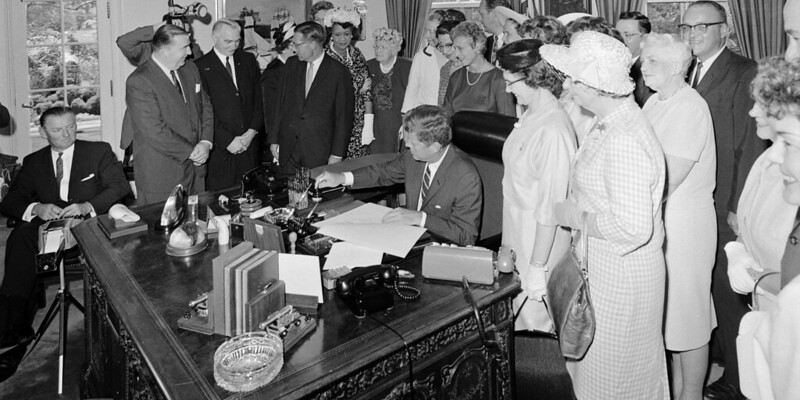
The Equal Pay Act was passed on June 10, 1963, but 58 years later women continue to earn less than men.
Two recently released analyses from the Women’s Bureau show that, on average, women earn 80% to 83% of what men do, and most of this gender wage gap cannot be explained by differences in men’s and women’s work histories, work hours, industry and occupation distribution, or job characteristics.
On average, women working full-time, year-round earned $47,299 in 2019 while men working full-time, year-round earned $57,456. For women of color the wage gap is even greater: Black women earn 63% of what white non-Hispanic men are paid and Latinas are paid 55% as much.
Occupational segregation, the devaluation of work traditionally done by women, and caregiving penalties that fall disproportionately on women all contribute to the wage gap. Our recent research confirms that occupations employing a larger share of women paid lower wages on average than similar male-dominant occupations, and these wage differences could not be explained away by the characteristics of the workers or the requirements of the jobs.
At the same time that women are sorted into lower-wage work, many also experience wage penalties related to their caregiving responsibilities. Only 20% of U.S. workers have access to paid family leave through work, and in part-time jobs and the service sector – where many working women are concentrated – it is often difficult to take leave without work-related repercussions. This means workers who care for children or elderly parents may have to choose between taking care of their loved ones when they are ill or losing a day’s worth of pay, if not their job.
As the country emerges from the pandemic, we don’t want to simply return to “normal” – we want to build back better and provide an equitable recovery for all workers. Let’s realize the aspirations of the Equal Pay Act by supporting the logical next steps that will move us toward true pay equity.
It’s on us to end to the insidious vestiges of gender-based pay discrimination, create pathways to good-paying jobs for women, value the jobs traditionally held by women, and provide a work-life balance that encourages women’s participation in our economy by expanding access to paid leave.
At the Women’s Bureau, we are expanding pathways to higher-paying jobs via the Women in Apprenticeship and Nontraditional Occupations (WANTO) grant program, which seeks to increase the number of women in registered apprenticeships and historically male-dominated jobs. We’re also developing a database to track child care costs and how they relate to women’s labor force behavior, and are working to document the long-term financial costs of caring, which fall disproportionately on women.
Policies to promote equal pay are essential to helping everyone succeed, both men and women alike. As Women’s Bureau Director Wendy Chun-Hoon says, “If the economy doesn’t work for women, it doesn’t work.”
Charmaine Davis is the regional administrator for the U.S. Department of Labor’s Women’s Bureau in the Southeast, Midwest and South Central states. Follow the bureau on Twitter at @WB_DOL.
Building on a Century of Progress
By Wendy Chun-Hoon | June 4, 2023

What do an English text book, a name badge and desk plate and a baby pacifier have in common? These were four of the items the Women’s Bureau presented to President Bill Clinton in a sealed time capsule for the agency’s 75th anniversary in 1995. These items, along with a movie script, a computer disk, sewing supplies, an EEG printout and more, represented the trades of 22 working women. While much has changed since then, there are striking similarities in the workplace challenges described in 1995 and those voiced by women in 2023 – challenges exacerbated over the last year by the devastation of COVID-19.
Unfortunately, the capsule broke before our centennial anniversary last year – in some ways an apt metaphor of the challenges working women have long endured.
For more than a century, the Women’s Bureau has supported women workers on their professional journeys, advocating for workplace and policy change that address gender-based employment inequities out of the realm of the purely personal and embeds them firmly in public discussion of policy solutions. We have been and continue to be diligent reporters, prescient visionaries and ardent advocates, documenting the experiences of women on the job, anticipating future trends and drawing new roadmaps to cultivate better workplaces.
COVID-19 has amplified the importance of the Women’s Bureau’s mission. It has brought the essential nature of the paid and unpaid work that women do into stark relief – from the frontlines of public health, education, caregiving and food service, to our own homes. It has revealed the glaring disconnect between the fundamental necessity of certain work and the correspondingly low wages and benefits for those who perform the work, predominantly women of color.
The global pandemic has made more urgent our call for paid leave, accessible and affordable child care, equal pay and health insurance. It has elaborated what we have always known: that women’s work is valuable work, and that workplace flexibility and family-friendly practices enhance businesses operations and economic productivity. With the right work-family supports, combined with workplaces free from discrimination and harassment, and level playing fields where equal opportunity wins the day, women and families thrive, and industry prospers.
Over the years, the Women’s Bureau has articulated novel frameworks to improve the workplace for women. From its first decades, when the agency’s mission was shaped by the industrial revolution and two world wars, the Women’s Bureau continually adapted to the increasing volume and diversity of women workers.
In the 1960s, the final report of the Presidential Commission on the Status of Women, chaired by Eleanor Roosevelt, outlined a unified agenda to address the barriers faced by women in the workplace, including the need for paid leave, affordable child care and elimination of racism against black women.
In the 1970s, we published curricula to move women into the trades. By the 1980s we held the first conference on “contingent workers,” and established the work and family clearinghouse. In the 1990s our research report, “Unnecessary Losses” documented the need for the Family and Medical Leave Act and paid leave.
At the dawn of the 21st century, we pushed for equity in STEM jobs and the emerging tech sector and we called attention to the unique challenges of women with disabilities; immigrant and Native women; women veterans; military spouses; black, brown and Asian women; teen parents and older women workers.
As we look toward the next hundred years of service, we recognize that we have a unique opportunity to build on the work of our predecessors and create new and better solutions for working women. The pandemic eroded women’s employment gains in material ways, the extent and persistence of which is not yet fully understood. The American workplace is constantly changing, bringing new (and in some cases exacerbating all-too-familiar) challenges. The difficulties are real, but we have the tools and the blueprint to construct a more just and equitable workplace. We must meet this moment with a once in a generation opportunity to transform conditions for work and workers that build our economy. That means implementing policies that deliver the opportunity, flexibility and equity to level the playing field for the diverse community of America’s women workers.
Wendy Chun-Hoon is the director of the U.S. Department of Labor’s Women’s Bureau. Follow the Women’s Bureau on Twitter at @WB_DOL.
The Diverse Experiences of AANHPI Women at Work
By: Hari Chon, Gretchen Livingston | May 21, 2023
While Asian American, Native Hawaiian and Pacific Islander women are often referred to collectively, they are far from a monolithic group. Instead, the AANHPI population includes many groups with varying demographic profiles, histories and experiences in the U.S. Some have resided here for a century, while others have a much more recent immigrant experience. Some came to this country to attain a higher education, while others arrived as refugees with perhaps nothing but the clothes on their backs. Many live and work in California and Hawaii, while others are scattered across the nation.
At the Women’s Bureau, we believe one way to help AANHPI communities is through data-driven storytelling. As we celebrate the cultural diversity of Asian Americans, Native Hawaiians and other Pacific Islanders this May, here are some key statistics about the 8.5 million AANHPI women in the U.S., more than 5 million of whom are in the labor force.
1. Labor force participation rates vary significantly within AANHPI groups.
Two-thirds of Filipinas were in the labor force in 2019, compared with about half of Japanese American women, and 59% of all women.
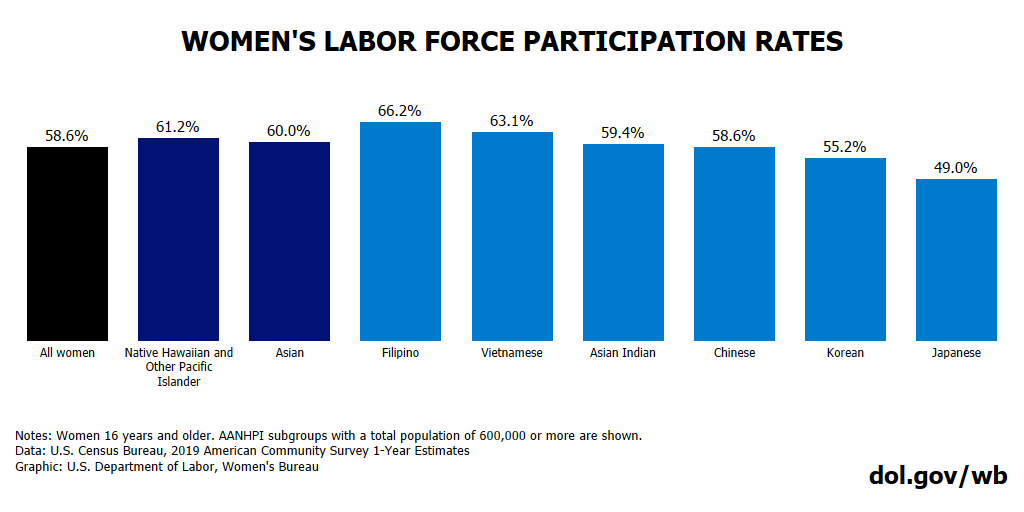
2. Unemployment rates also varied significantly.
Among AANHPI women in the labor force, the share that were unemployed was the highest among Pacific Islanders (6.3%). Unemployment rates were about half as high for Vietnamese, Japanese and Chinese women. In comparison, 4.4% of all U.S. women in the labor force were unemployed in 2019.
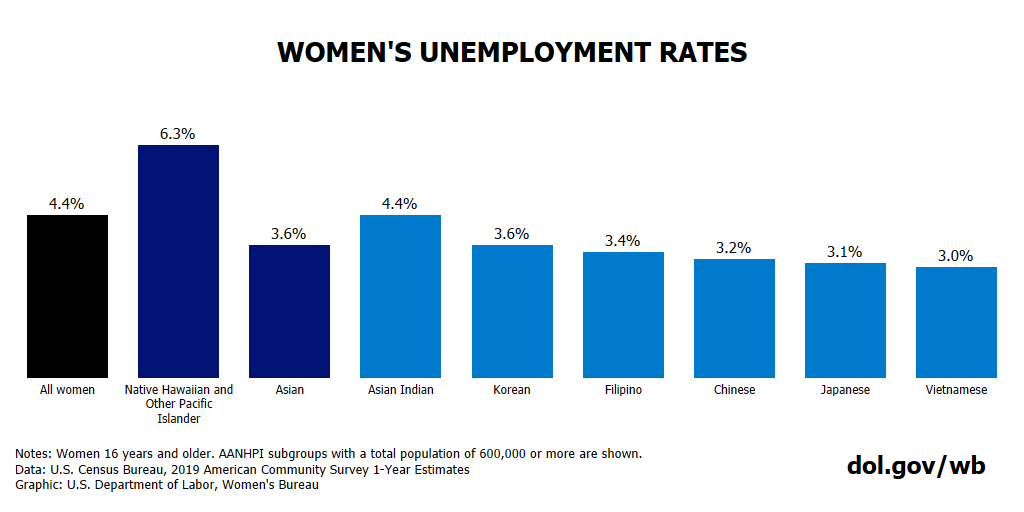
3. The occupational profiles of AANHPI women in the U.S. varied dramatically.
While 70% of employed Asian Indian women work in management, business, science and the arts, the share of Pacific Islander women and Vietnamese American women who do so is only half as high. Meanwhile, relatively large shares of these two groups are employed in service and sales.
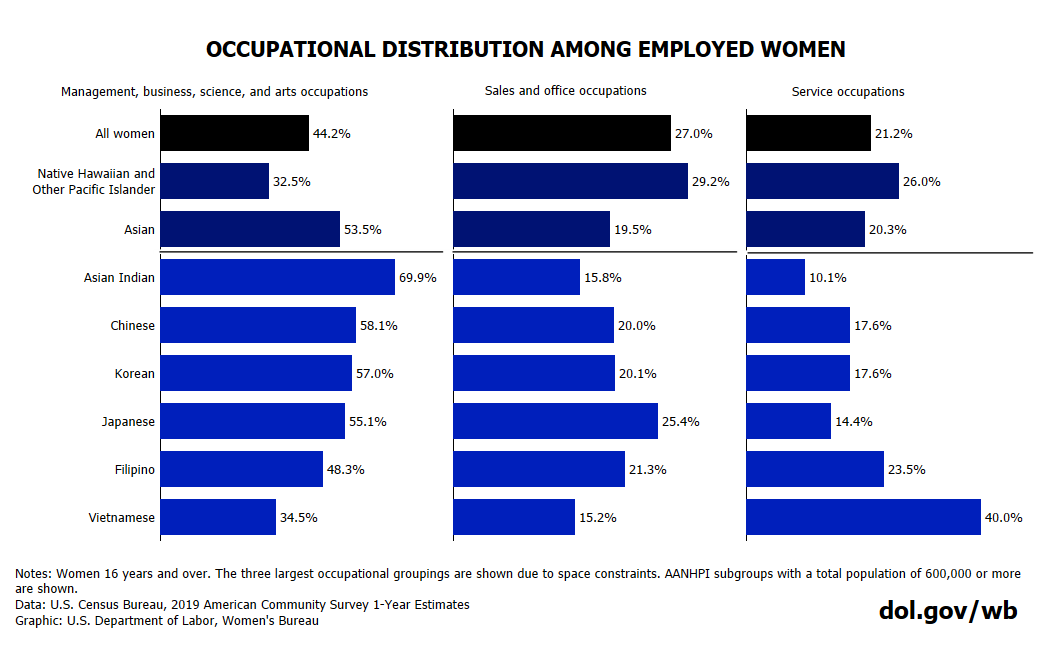
4. Differences in occupational composition across subgroups likely explain dramatic earnings differences.
Indian American women, who were concentrated in managerial and professional occupations, have median annual earnings of about $76,000. Pacific Islander and Vietnamese American women, who were concentrated in sales and service occupations, have the lowest median wages ($38,900 and $40,500, respectively). To put this in perspective, the median wage is $43,200 for all women employed full time.
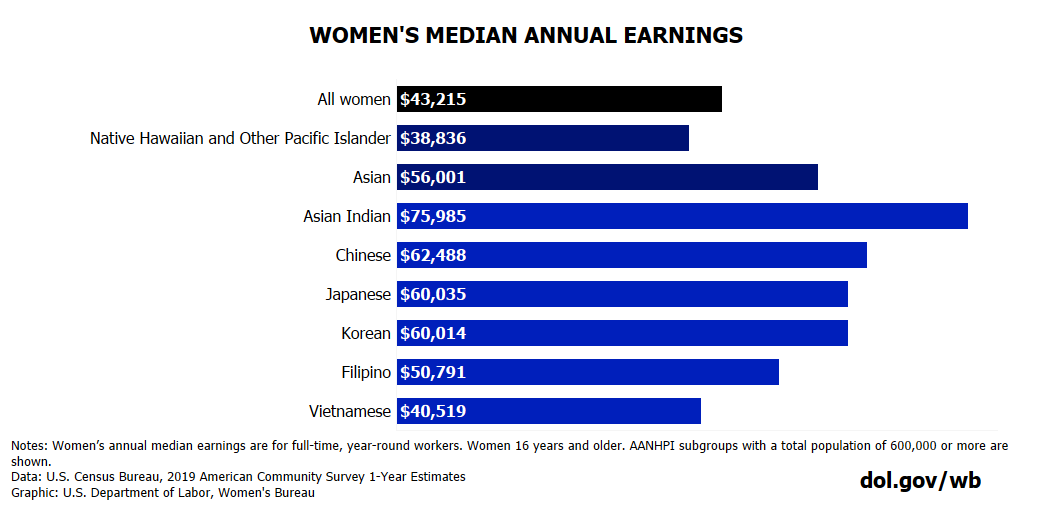
5. Underlying many of these labor force differences are stark educational differences.
While almost three-fourths of Asian Indian women have earned at least a bachelor’s degree, the same is true for only 31% of Vietnamese and 19% of Pacific Islander women. On the flip side, the share of women who lack a high school diploma ranges from 27% among Vietnamese American women to 5% among Japanese American women.
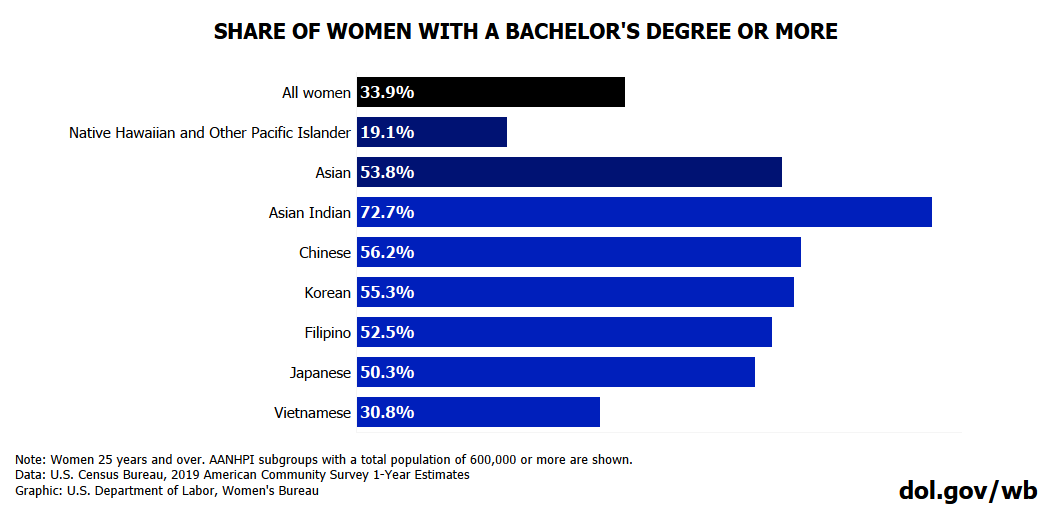
Even looking only at the largest AANHPI groups in the U.S., we see tremendous diversity. Recognizing this diversity can help us develop more effective policies and programmatic interventions across these communities. Thinking of AANHPI women as one group masks their vastly different experiences in the U.S. labor force. Breaking down the data is one way we’re helping AANHPI working women and making their voices heard.
Hari Chon is a policy analyst and Gretchen Livingston is a survey statistician at the U.S. Department of Labor's Women's Bureau. Follow the bureau on Twitter at @WB_DOL.
Technical note on Asian Americans and Native Hawaiian and Pacific Islanders:
These analyses are based on the following single-race classifications:
Asian: a person having origins in any of the original peoples of the Far East, Southeast Asia or the Indian subcontinent including, for example, Cambodia, China, India, Japan, Korea, Malaysia, Pakistan, the Philippine Islands, Thailand and Vietnam. It includes people who indicate their race as "Asian Indian," "Chinese," "Filipino," "Korean," "Japanese," "Vietnamese" and "Other Asian" or provide other detailed Asian responses.
Native Hawaiian and Other Pacific Islander: a person having origins in any of the original peoples of Hawaii, Guam, Samoa or other Pacific Islands. It includes people who indicate their race as "Native Hawaiian," "Guamanian or Chamorro," "Samoan" and "Other Pacific Islander" or provide other detailed Pacific Islander responses.
|
Women's labor force participation rates |
|
|
Race and ethnicity |
LFP rate |
|
All women |
58.6 |
|
Asian |
60.0 |
|
Asian Indian |
59.4 |
|
Chinese |
58.6 |
|
Filipino |
66.2 |
|
Japanese |
49.0 |
|
Korean |
55.2 |
|
Vietnamese |
63.1 |
|
Native Hawaiian and Other Pacific Islander |
61.2 |
Notes: Women 16 years and older. AANHPI subgroups with a total population of 600,000 or more are shown. Data: U.S. Census Bureau, 2019 American Community Survey 1-Year Estimates
|
Women's unemployment rates |
|
|
Race and ethnicity |
rate |
|
All women |
4.4 |
|
Asian |
3.6 |
|
Asian Indian |
4.4 |
|
Chinese |
3.2 |
|
Filipino |
3.4 |
|
Japanese |
3.1 |
|
Korean |
3.6 |
|
Vietnamese |
3.0 |
|
Native Hawaiian and Other Pacific Islander |
6.3 |
Notes: Women 16 years and over. AANHPI subgroups with a total population of 600,000 or more are shown. Data: U.S. Census Bureau, 2019 American Community Survey 1-Year Estimates
|
Occupational distribution among employed women |
|||
|
Race and ethnicity |
Management, business, science, and arts occupations |
Service occupations |
Sales and office occupations |
|
Native Hawaiian and Other Pacific Islander |
32.5 |
26.0 |
29.2 |
|
Vietnamese |
34.5 |
40.0 |
15.2 |
|
All women |
44.2 |
21.2 |
27.0 |
|
Filipino |
48.3 |
23.5 |
21.3 |
|
Asian |
53.5 |
20.3 |
19.5 |
|
Korean |
57.0 |
17.6 |
20.1 |
|
Japanese |
55.1 |
14.4 |
25.4 |
|
Chinese |
58.1 |
17.6 |
20.0 |
|
Asian Indian |
69.9 |
10.1 |
15.8 |
Notes: Women 16 years and over. The three largest occupational groupings are shown. AANHPI subgroups with a total population of 600,000 or more are shown. Data: U.S. Census Bureau, 2019 American Community Survey 1-Year Estimates
|
Women's median annual earnings |
|
|
Race |
Median earnings |
|
All women |
$43,215 |
|
Asian |
$56,001 |
|
Asian Indian |
$75,985 |
|
Chinese |
$62,488 |
|
Filipino |
$50,791 |
|
Japanese |
$60,035 |
|
Korean |
$60,014 |
|
Vietnamese |
$40,519 |
|
Native Hawaiian and Other Pacific Islander |
$38,836 |
Notes: Women’s annual median earnings are for full-time, year-round workers. Women 16 years and older. AANHPI subgroups with a total population of 600,000 or more are shown. Data: U.S. Census Bureau, 2019 American Community Survey 1-Year Estimates
|
Share of women with a bachelor's degree or more |
|
|
Race |
Bachelor's degree or higher |
|
All women |
33.9 |
|
Asian |
53.8 |
|
Asian Indian |
72.7 |
|
Chinese |
56.2 |
|
Filipino |
52.5 |
|
Japanese |
50.3 |
|
Korean |
55.3 |
|
Vietnamese |
30.8 |
|
Native Hawaiian and Other Pacific Islander |
19.1 |
Note: Women 25 years and over. AANHPI subgroups with a total population of 600,000 or more are shown. Data: U.S. Census Bureau, 2019 American Community Survey 1-Year Estimates
A Year of Challenges and Progress, With More Work Ahead
By Hari Chon | May 17, 2023
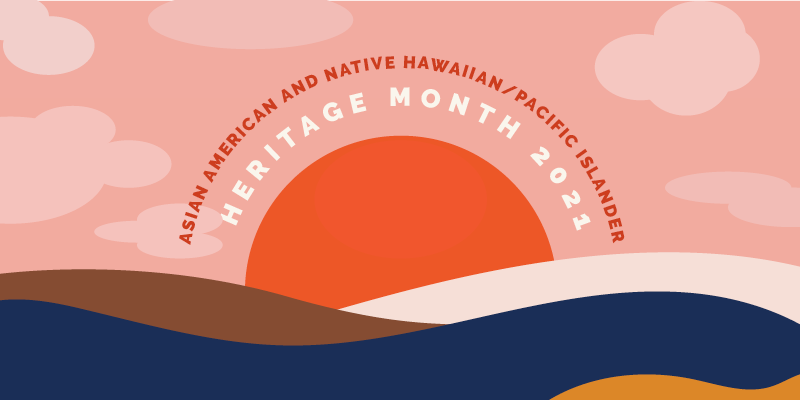
This year, National Asian American and Native Hawaiian/Pacific Islander Heritage Month feels different. On the one hand, longstanding prejudice and discrimination towards Americans of Asian Pacific descent has been heightened as a result of the pandemic.
At the same time, we’re celebrating unprecedented representation – including the first female, Black and Asian Vice President, Kamala Harris, the first Asian American U.S. Trade Representative, Katherine Chi Tai, and new members of Congress of East Asian, Southeast Asian, South Asian or Pacific Islander descent. Asian Pacific Americans are the second fastest-growing population among major race and ethnic groups, and their stories are central threads in the fabric of our shared history.
Amid the global pandemic and the rise in acts of violence against AANHPI Americans, the public-facing nature of industries where Asian Americans figure prominently – as healthcare workers, small business owners and food service workers – pose very real risks to the health and well-being of Asian American workers and proprietors. Beyond the health impacts, the economic impacts of the pandemic on Asian Americans have been substantial. According to the Census Bureau, a quarter of the nation’s 578,000 businesses owned by this group belonged to the Accommodation and Food Services sector, which was particularly hard hit by the pandemic.
The negative impact of the pandemic on the restaurant industry was deeply personal to me. Like many Asian immigrants, my parents built a loyal customer base with our family restaurant, a labor of love and commitment with a proud 18-year history in our community. Despite setbacks and challenges along the way, my parents will tell you that the American Dream is alive and well for Asian Pacific American communities and that theirs is still being written.
The growing numbers and greater visibility of AANHPI leaders, including women in positions of power, gives me hope for the future. Their stories of perseverance encourage all of us to keep moving forward even in the face of challenge and adversity. While the past year has witnessed an increase in acts of aggression and hatred towards members of the Asian Pacific American community across the nation, I am still heartened by what I see as clear evidence of renewed commitment to a set of shared values that demands fairness, equity and justice.
Let us take this moment to celebrate how far we’ve come, and also to recommit ourselves to the obligations of our shared humanity such that our fellow Asian Pacific American friends, family and neighbors never again have to endure a year like the past one.
Hari Chon is a policy analyst in the U.S. Department of Labor’s Women’s Bureau. Follow the bureau on Twitter at @WB_DOL.
5 Facts on Moms, Work and COVID-19
by Wendy Chun-Hoon | May 6, 2023
With widespread closures of schools and childcare centers, COVID-19 kicked away the scaffolding of care working families rely on to balance the demands of work and family. Mothers, in particular, have borne a heavy load.
While the amount of time and energy they spend on unpaid labor at home has skyrocketed, their employment has suffered. Along with increases in household food insecurity, many moms also reported other effects of the pandemic beyond the labor market, including increased stress and anxiety. As the United States approaches its second pandemic Mother’s Day, here are five facts about how the pandemic has affected moms.
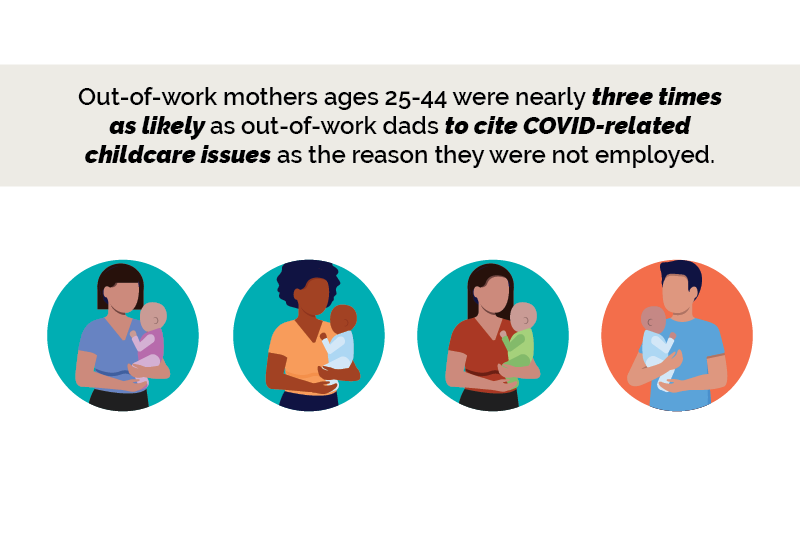
1. Maternal employment took a hit due to school and daycare closures
Even before the pandemic, childcare responsibilities fell primarily to mothers. Despite progress in this area, moms still spend almost twice as much time caring for kids as fathers do. The onus of child care and homeschooling continued to fall primarily on women in the pandemic: Among adults ages 25-44, out-of-work moms were nearly three times as likely (32% vs. 12%) as out-of-work dads to cite COVID-related childcare issues as the reason they were not employed, in a July 2020 survey.
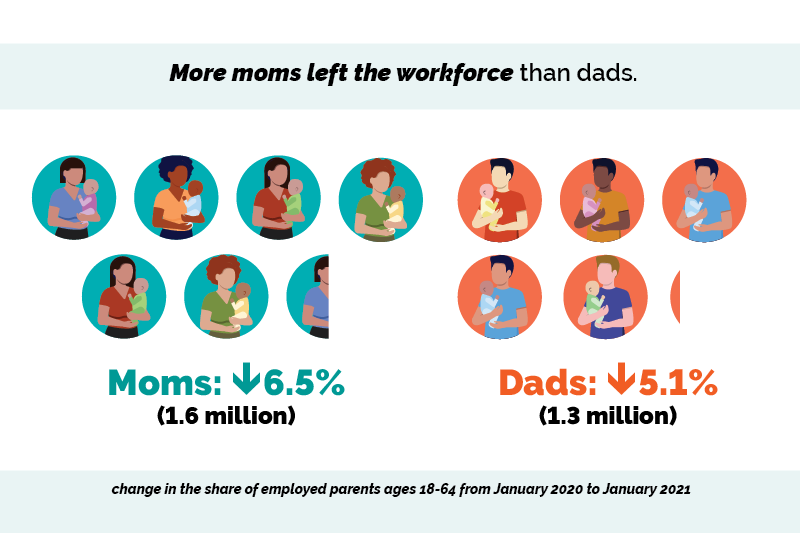
2. More moms left the workforce than dads
About 1.6 million fewer mothers of children under 18 were working in January 2023 than in January 2020, representing a 6.5% decline. In comparison, the number of working fathers declined by 1.3 million, or 5.1%. Not only were fewer moms working, but many employed moms scaled back on working hours to a larger extent than fathers.
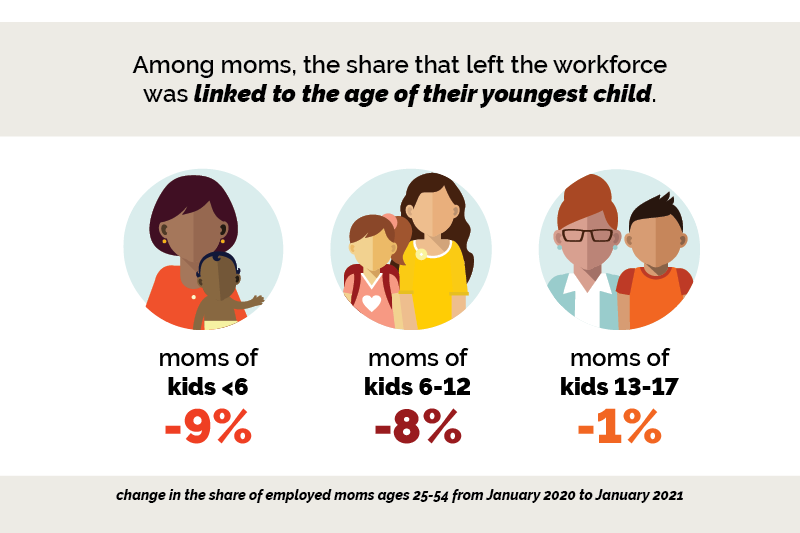
3. Moms with young kids were more affected
Among moms, workforce exits in the past year were linked to the age of their children: 9% of those with preschool-aged children left the workforce between January 2020 and January 2023, as did 8% of moms with children ages 6-12, but just 1% of moms with children ages 13-17.
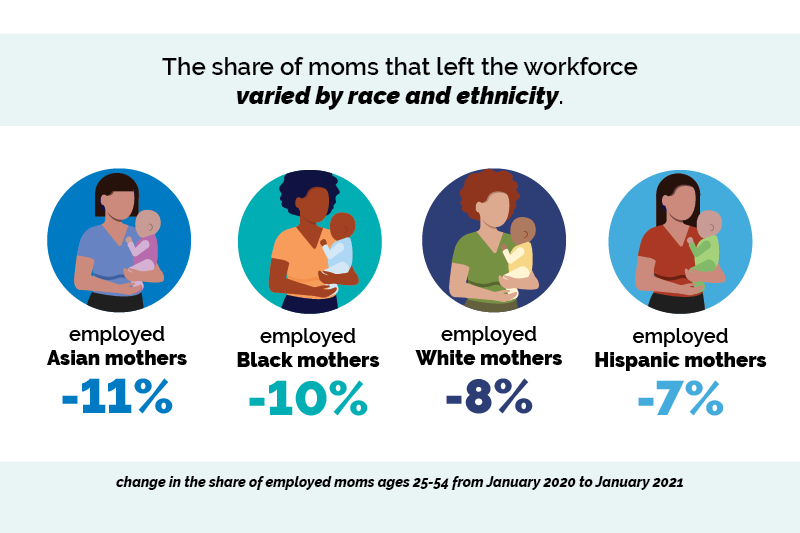
4. Asian and Black moms faced the steepest employment losses
Between January 2020 and January 2023, 11% of Asian working moms with children 12 or younger and 10% of Black moms left the workforce. In comparison, 8% of white mothers did so, as did 7% of Hispanic moms. Racial and ethnic variations in employment losses were due in part to systemic racism, reflected in factors such as occupational segregation and disparities in unemployment and access to paid leave.
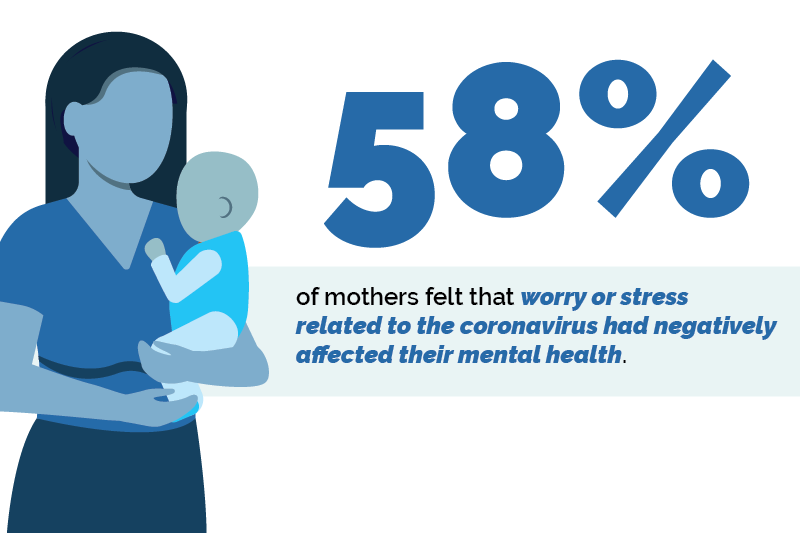
5. Impacts extended far beyond the labor market
A year into the pandemic, 58% of mothers reported that worry or stress related to the coronavirus has negatively affected their mental health, according to a recent survey. The increase in their unpaid work – both childcare and housework – along with increased job loss are important factors contributing to relatively high levels of anxiety and insomnia. These unpaid work demands and job loss rose along with food insecurity in households with children. By the summer of 2020, the share of households with children that did not have enough food more than doubled, from 14% pre-pandemic to more than 30%, with higher rates in households with children of color.
The pandemic has presented stark reminders of the present system’s gross inadequacy in supporting working moms. This is a pivotal moment, full of promise. We are truly on the cusp of bold, transformative policymaking that meets the needs of mothers and their families, both in the home and in the workplace.
The Biden-Harris administration has already provided immediate financial support to families and small businesses with the American Rescue Plan. The next step is to implement the American Jobs Plan and the American Families Plan. Doing so will help build a new economy – one that recognizes that care work is infrastructure, that it undergirds strong families, and is essential to a prosperous economy.
By creating a national paid family and medical leave program, increasing the size of the country’s care work infrastructure, improving benefits and wages so that the care workforce can support their own families, and implementing tax credits and financial supplements with historic potential for reducing child poverty, these plans will create long-overdue supports so parents won’t have to choose between caring for the families they love, and keeping their jobs.
Find more data on working mothers on the Women’s Bureau’s website.
Wendy Chun-Hoon is the director of the U.S. Department of Labor’s Women’s Bureau. Follow the Women’s Bureau on Twitter at @WB_DOL.
From Triangle to COVID: Answering the Call to Protect American Workers
By Analilia Mejia | March 25, 2023

On March 25, 1911, a fire broke out in the Triangle Shirtwaist Company on the top floors of the Asch Building, near Washington Square Park in New York City. Many of the workers were women, some as young as 14, and most were immigrants. The fire spread quickly, and workers who rushed to the exits found they had been locked in by their managers – a common practice at the time.
An estimated 146 workers perished in the fire. Witnesses watched in horror as some jumped from the ninth floor and fell to their deaths. Among the witnesses was future Secretary of Labor Frances Perkins, who carried the memory of the fire throughout her long career advocating for better workplace protections.
At the start of the 20th century, and the close of the second industrial revolution, many American women had found expanded opportunities for employment in a growing textile industry, rapidly transformed through the expansion of machinery and demand. Despite these expanding opportunities, working conditions in these factories were often miserable.
The nation’s labor movement was also in the process of transition, transforming from craft guilds into organizing bodies representing exploited lower skilled factory workers, and these bodies increasingly called for change within the industry. In 1909, 20,000 workers, mostly women, struck in demand for safer working conditions.
Despite the size of the strike, dangerous conditions persisted, as the Triangle fire proved. The tragedy awoke the public to the need for a change in a way that previous efforts had failed to do. With broader support, the ongoing efforts of the labor movement, and the support of Frances Perkins, conditions began to improve.
When President Roosevelt asked her to be the Secretary of Labor, she had already prepared a set of labor policy priorities including a 40-hour work week, Social Security, health insurance, minimum wage, unemployment compensation, workers’ compensation and abolishing child labor.
One hundred and ten years later, we can see echoes of the Triangle tragedy in the COVID-19 pandemic. In the early twentieth century, the U.S. economy benefitted from the labor of young, immigrant workers, often toiling in dangerous and exploitative conditions. The pandemic has revealed the extent to which our economy still relies on the labor of essential workers, many of them female, with limited protections.
Women, especially women of color, are disproportionately represented in public-facing service jobs that have been hard-hit by lack of adequate personal protective equipment and paid leave. The growth of gig and service work, coupled with decreasing union representation for these workers, has left many without the resources to collectively improve their workplaces.
Working women are having to choose between staying safe and supporting their families, between employment and the essential but unpaid work caring for family members. Since February 2020, Black women’s labor force participation rate has declined by 4.2 percentage points, compared to 4.1 percentage points among Hispanic women, and 1.9 percentage points among White women.
Furthermore, millions of working women, in particular women of color, who make up a large share of service sector jobs that cannot be done remotely, have found themselves unemployed. About 9.7% fewer Black women, 8.6% fewer Hispanic women, and 5.4% fewer White women were employed in February 2023 compared with February 2020. These changes have set women’s labor force participation back about 30 years, and will undoubtedly have a lasting impact on the economic security of these women and their families.

The American Rescue Plan directly addresses many of the challenges and risks faced by workers during the pandemic . Measures include providing direct stimulus payments, expanding unemployment benefits, providing funding to expand access to personal protective equipment, accelerating vaccinations, providing tax credits to businesses that offer emergency paid leave, increasing tax credits to cover the cost of childcare, and much more. These measures will not only help protect essential workers from the virus, but also provide more comprehensive supports for employed and displaced workers alike.
While this legislation has provided much needed aid to working women, opportunities remain to advance women in the workforce. For more than a century, the Department of Labor has led the charge in supporting the American workforce and setting generations upon a path of greater economic security. By pursuing policies that support historically overlooked workers, we can ensure that today’s workers and tomorrow’s will be better protected than the generations that came before.
Analilia Mejia is the deputy director of the U.S. Department of Labor’s Women’s Bureau. Follow the Women's Bureau on Twitter: @WB_DOL.
Helping Working Black Women Reach Their Full Potential in the Workplace
By Joan Harrigan-Farrelly | February 22, 2023

Recently, I was invited to speak at an event honoring the life and work of Dr. Martin Luther King, Jr. I am moved by so many of his speeches, but one quote in particular captures the essence of our equity work at the Women’s Bureau, “Whatever affects one directly, affects all indirectly. I can never be what I ought to be until you are what you ought to be.”
This year’s National African American History Month theme is “Black Family: Representation, Identity and Diversity.” As we take time to celebrate the diversity of Black families and reflect on the remarkable achievements and contributions of generations of African Americans in the United States, we must also recognize this is a difficult time for many.
According to the Centers for Disease Control and Prevention, Black men and women are two times more likely than their white counterparts to experience the loss of a loved one and almost three times more likely to know someone who has been hospitalized from COVID-19.
While Black women historically experience the highest labor force participation among women and are more likely to hold multiple jobs than other women or men, throughout the pandemic, Black women have endured the highest unemployment rates. More than half of employed Black women worked in industries hit the hardest by COVID-19.

In 2020, Black women who were full-time wage earners had median usual weekly earnings of $764, or only 68.8 percent of the $1,110 median usual weekly earnings of white men. This is important to note since 52.3 percent of Black mothers are raising children on their own: Black working mothers’ earnings are essential for the economic security of Black families.
The Women’s Bureau has always been at the forefront of advocating for working women, including supporting racial equity and inclusion in the workplace through our initiatives and research. This work goes as far back as 1922, when we published a detailed statistical report that revealed the working conditions for Black women during that time.
We’ve also been at the center of the push for working women’s rights, ensuring that women were included in the Fair Labor Standards Act in 1938; and playing an instrumental role in the Equal Pay Act of 1963, the Pregnancy Discrimination Act of 1978 and the Family and Medical Leave Act of 1993. These policies have advanced women’s employment prospects and working conditions – yet they have also not been sufficient to ensure equity for Black women in the workforce.
Many Black women are essential workers, and are less likely to have remote work flexibilities. This lack of workplace flexibilities is one of the driving forces behind the Women’s Bureau’s work in the area of paid leave and child care. In recent years, we have advocated for racial and gender equity through a combination of grant-making, education and outreach, and other advocacy work focused on these key policy issues.
It is incumbent on us at the Women’s Bureau, and indeed, on all of us, to recognize and remedy the structural and systemic inequities, the implicit bias, and sometimes the unvarnished racism that constrain women of color from reaching their fullest potential in the workplace and in many other arenas. This is one way that we can fulfill the aspiration of this year’s Black History Month.
We encourage you to follow us on Twitter at @WB_DOL as we continue to elevate research regarding these inequities and mount programmatic responses to combat them.
For more information about the Women’s Bureau, please visit www.dol.gov/wb .
Joan Harrigan-Farrelly is the deputy director of the Women’s Bureau at the U.S. Department of Labor.
Share of Employed Black Women by Industry
| Education and health services | 41.0% |
| Wholesale and retail trade | 10.5% |
| Professional and business services | 9.3% |
| Leisure and hospitality | 8.1% |
| Public administration | 8.0% |
Note: Industries with less than 8% share of employed Black women not shown
Source: BLS Current Population Survey, 2020 annual averages
U.S. Department of Labor Announces Award of Grants to Help Women Affected by the Opioid Crisis Re-enter Workforce
News Release, September 30, 2019
The U.S. Department of Labor has awarded nearly $1.5 million in WANTO grant funding to organizations in Illinois, Virginia, and Wisconsin to help recruit, train, and retain more women in quality pre-apprenticeship and apprenticeship programs.
Learn more about RESTORE and 2019 grantees
See news release
Read FAQs
USDOL Awards Nearly $1.5 Million to Increase Apprenticeship Participation, Expand Job Opportunities for American Women
April 28, 2019
The U.S. Department of Labor has awarded nearly $1.5 million in WANTO grant funding to organizations in Illinois, Virginia, and Wisconsin to help recruit, train, and retain more women in quality pre-apprenticeship and apprenticeship programs.
Learn more about WANTO and 2019 grantees
See news release
Read FAQs
U.S. Department of Labor Announces $2.5 Million to Support Women Affected by Opioid Crisis
News Release, July 24, 2019
On July 24, the Women’s Bureau announced a new grant program to help women affected by the opioid crisis re-enter the workforce. The Re-Employment, Support, and Training for the Opioid Related Epidemic (RESTORE) grant will award $2.5 million to organizations that assist in providing coordinated, employment-focused services to women.
See news release
Apply here by April 23, 2019
Read FAQs
Honoring Oleta Crain, an American Hero
by Marzy Bedford-Billinghurst | February 8, 2018
Oleta Lawanda Crain (1913-2007) joined the Women’s Army Auxillary Corp (WAAC) in 1942.
From Apprenticeship to Mentorship
by Eric R. Lucero | December 20, 2017
Charmaine Davis, the Women’s Bureau regional administrator in Atlanta, knows young women need role models like Beatrice to show them the way.
Apprenticeship Helps Montana Woman Keep the Lights On
by Leo Kay| November 21, 2017
Only 3 percent – or 23,000 – of the estimated 774,000 electricians working in the country are women. Sierra Smith is one of them, thanks to hard work, determination, and an assist from Montana’s apprenticeship program.
By the Numbers: Hispanic Women in the Workforce
by Tracie Sanchez | October 13, 2017
In recognition of Hispanic women’s significant contributions to the labor force, here are six statistics demonstrating their growing influence as drivers of economic productivity and entrepreneurs.
5 Facts About Working Women and Retirement
by Tiffany Boiman, Mark Connor | September 18, 2017
Ensuring women’s economic security through retirement can, and should, start early − and we have resources to help.
Celebrating 97 Years of Advocacy for Working Women
by Tracie Sanchez | June 5, 2017
First created during World War I to study women’s employment during and after the war, the Women’s Bureau became a permanent federal government fixture in 1920.
By the Numbers: Happy Mother’s Day!
by Liana Christin Landivar | May 12, 2017
Seventy percent of mothers with kids under the age of 18 are in the labor force.
A History of Achievements
by Michelle Vaca | May 30, 2017
There are many examples of AAPI women that have made remarkable contributions to the science, technology, engineering and mathematics, or STEM, fields.
Trailblazing Women in STEM
by Joan Harrigan-Farrelly | March 21, 2017
During National Women’s History Month, with the 2017 theme of “Honoring Trailblazing Women in Labor and Business,” we recognize trailblazing work being done to bring more women into these fields.
Crossing the Finish Line
by Joan Harrigan-Farrelly | February 24, 2017
At the Women’s Bureau, we work to ensure that “the finish line” is within reach of all workers regardless of gender. This story offers several lessons that continue to have relevance for today’s working women.


